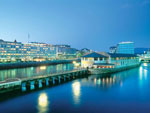 Seven high-risers were built in the central part of Moscow the late 1940s - in the early 1950s. Later they derived their sonorous name ‘Seven sisters’. Their construction was associated with Stalin's idea to decorate the capital after the Victory in World War II and to demonstrate the power of Russia, on the threshold of the 800th anniversary of Moscow.
Seven high-risers were built in the central part of Moscow the late 1940s - in the early 1950s. Later they derived their sonorous name ‘Seven sisters’. Their construction was associated with Stalin's idea to decorate the capital after the Victory in World War II and to demonstrate the power of Russia, on the threshold of the 800th anniversary of Moscow.
It was initially planned to build eight skyscrapers, but construction of the eighth building was stopped right after Stalin's death. Later, Hotel Russia was erected on the basement of uncompleted project. Eight buildings were aimed to epitomize Moscow’s age and to surround the Palace of Soviets that never reached the stage of construction.
For the history of Russia and Moscow, ‘Seven sisters’ became a symbol of monumental architecture of Stalin’s epoch, they are often named ‘a top of a Stalin empire style’ in a city architecture. Similar skyscrapers were built at the same time in Kiev, Warsaw and Riga. All of them were aimed to symbolise power and high aspirations of the Soviet state.
Certain symbolism was inherent to each separate building: the Moscow State University building symbolised power of the Soviet science, a building of the Ministry of Foreign Affairs - authority of the USSR, the building in Kotelnichesky street became a symbol theatrical and motion picture arts etc. Symbols of these high-risers have not lost the value today, as well as the status of their tenants has not changed: it still indicates belonging to high society.
The main building of Moscow State University, the highest of all skyscrapers, is located in the distance from the other high-risers, behind the Vorobyevy Hills. Over 240 meters high, it used to be the highest building in Moscow for quite a long period of time. Leningradskaya Hotel of 136 metres high is the lowest and the oldest out of ‘Seven sisters’. It was built in 1947 by the day of the 800th anniversary of Moscow.
The 29-storied Ukraine hotel is 170 meters high. It was built after Stalin’s death in 1953-1957 and is now known as Radisson Royal.
The building of the Ministry for Foreign Affairs of Russia was built in 1948-1953, and its height is 172 metres. The Ministry building is distinguished by the rich interior coating made of natural marble and granite. The coating also has wooden panels of oak and Karelian birch. The national emblem of the USSR established at height of 114 metres is another important distinctive feature of this high-riser. Also, this building does not have the star on its spike.
 |
 |
 |
The rest of Stalin’s high-risers are residential. The 32-storied building on Kotelnicheskaya street was built in 1938-1952. Today it has 700 apartments, a few shops, a cinema, etc. The high-riser at the Red gates subway station is a little bit lower. It is called Red Gates Administrative Building, its right wing hosts one of the station’s lobbies. Another high-riser is a building on Kudrinskaya square, formerly known as a ‘high-riser at Vosstaniye square’. It consists of the central 22-storied, 156 meter high building and 18-storied side ones with 452 apartments. The side buildings form a harmonic connection with the surrounding structures.. It is necessary to notice that all seven high-risers were conceived as independent buildings with the closed household infrastructure: that is, they include cinemas, restaurants, shops, post and bank branches, and many other things.
Stalin high-risers are the present reflection of history of Russia in the middle of the 20th century, showcasing the greatness and indestructibility of the USSR. Today, all ‘Seven sisters’ can be seen only from Vorobyovy mountains. But it is much more interesting to stand in front of their facades when you can feel all their power and monumentalism.







